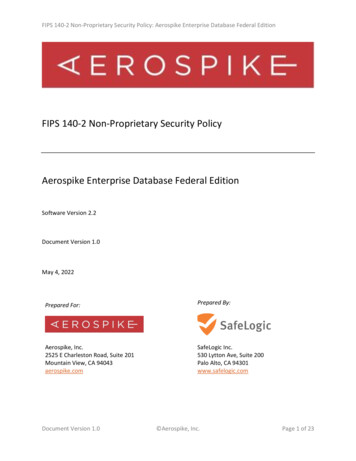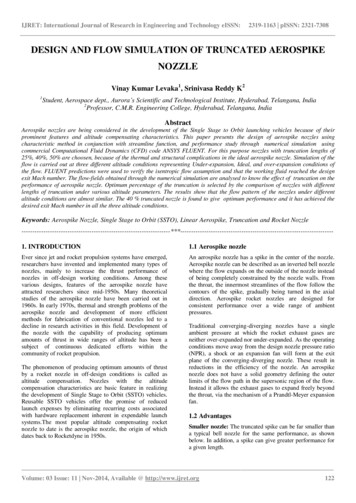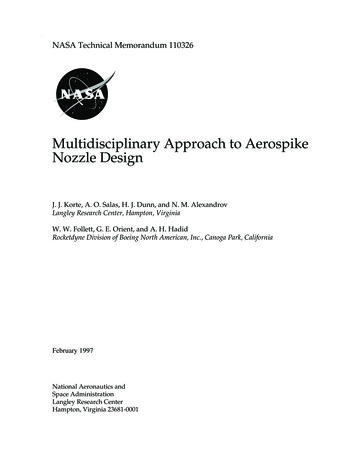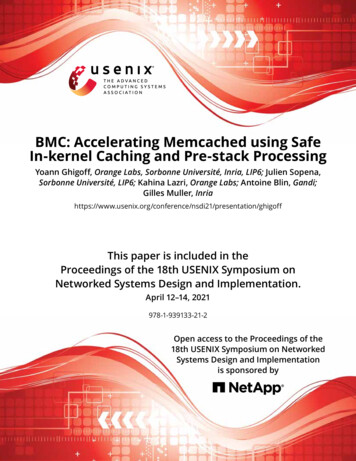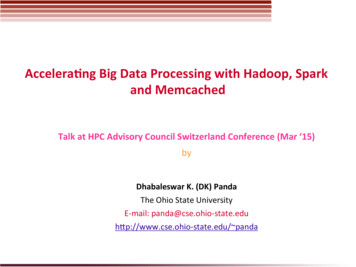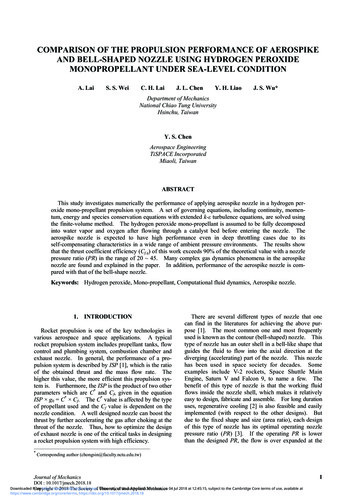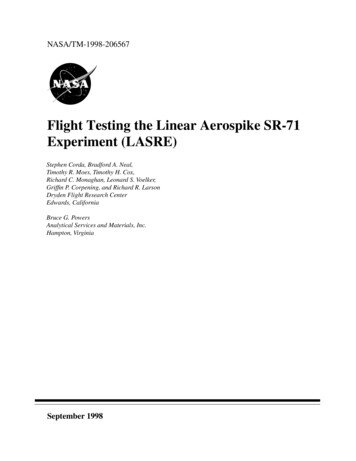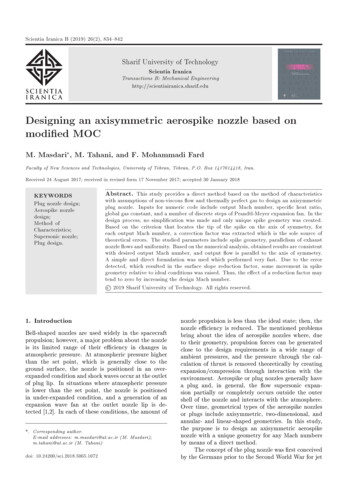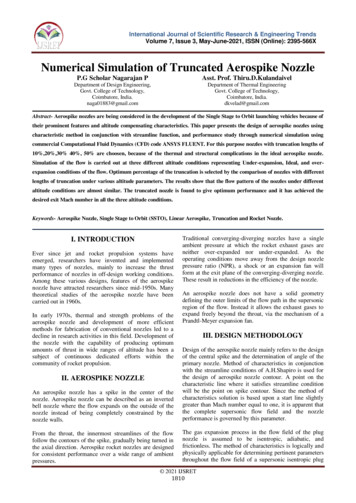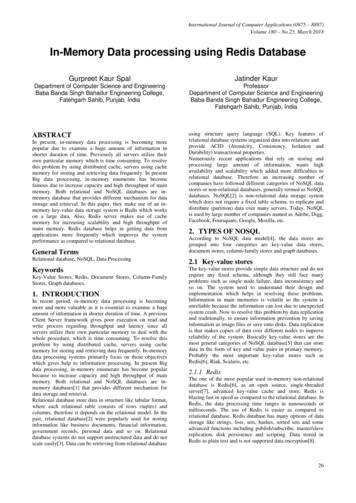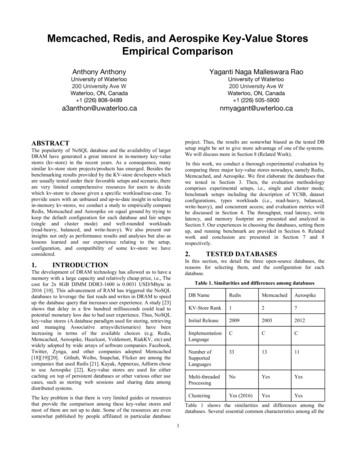
Transcription
Memcached, Redis, and Aerospike Key-Value StoresEmpirical ComparisonAnthony AnthonyYaganti Naga Malleswara sity of Waterloo200 University Ave WWaterloo, ON, Canada 1 (226) 808-9489University of Waterloo200 University Ave WWaterloo, ON, Canada 1 (226) 505-5900project. Thus, the results are somewhat biased as the tested DBsetup might be set to give more advantage of one of the systems.We will discuss more in Section 8 (Related Work).ABSTRACTThe popularity of NoSQL database and the availability of largerDRAM have generated a great interest in in-memory key-valuestores (kv-store) in the recent years. As a consequence, manysimilar kv-store store projects/products has emerged. Besides thebenchmarking results provided by the KV-store developers whichare usually tested under their favorable setups and scenario, thereare very limited comprehensive resources for users to decidewhich kv-store to choose given a specific workload/use-case. Toprovide users with an unbiased and up-to-date insight in selectingin-memory kv-stores, we conduct a study to empirically compareRedis, Memcached and Aerospike on equal ground by trying tokeep the default configuration for each database and fair setups(single and cluster mode) and well-rounded workloads(read-heavy, balanced, and write-heavy). We also present ourinsights not only as performance results and analyses but also aslessons learned and our experience relating to the setup,configuration, and compatibility of some kv-store we haveconsidered.1.In this work, we conduct a thorough experimental evaluation bycomparing three major key-value stores nowadays, namely Redis,Memcached, and Aerospike. We first elaborate the databases thatwe tested in Section 3. Then, the evaluation methodologycomprises experimental setups, i.e., single and cluster mode;benchmark setups including the description of YCSB, datasetconfigurations, types workloads (i.e., read-heavy, balanced,write-heavy), and concurrent access; and evaluation metrics willbe discussed in Section 4. The throughput, read latency, writelatency, and memory footprint are presented and analyzed inSection 5. Our experiences in choosing the databases, setting themup, and running benchmark are provided in Section 6. Relatedwork and conclusion are presented in Section 7 and 8respectively.2.TESTED DATABASESIn this section, we detail the three open-source databases, thereasons for selecting them, and the configuration for eachdatabase.INTRODUCTIONThe development of DRAM technology has allowed us to have amemory with a large capacity and relatively cheap price, i.e., Thecost for 2x 8GB DIMM DDR3-1600 is 0.0031 USD/Mbyte in2016 [10]. This advancement of RAM has triggered the NoSQLdatabases to leverage the fast reads and writes in DRAM to speedup the database query that increases user experience. A study [23]shows that delay in a few hundred milliseconds could lead topotential monetary loss due to bad user experience. Thus, NoSQLkey-value stores (A database paradigm used for storing, retrievingand managing Associative arrays/dictionaries) have beenincreasing in terms of the available choices (e.g. Redis,Memcached, Aerospike, Hazelcast, Voldemort, RiakKV, etc) andwidely adopted by wide arrays of software companies. Facebook,Twitter, Zynga, and other companies adopted Memcached[18][19][20]. Github, Weibo, Snapchat, Flicker are among thecompanies that used Redis [21]. Kayak, Appnexus, Adform choseto use Aerospike [22]. Key-value stores are used for eithercaching on top of persistent databases or other various other usecases, such as storing web sessions and sharing data amongdistributed systems.Table 1. Similarities and differences among databasesThe key problem is that there is very limited guides or resourcesthat provide the comparison among these key-value stores andmost of them are not up to date. Some of the resources are evensomewhat published by people affiliated in particular databaseDB NameRedisMemcachedAerospikeKV-Store Rank127Initial Release200920032012ImplementationLanguageCCCNumber NoYesYesClusteringYes (2016)YesYesTable 1 shows the similarities and differences among thedatabases. Several essential common characteristics among all the1
three databases are that they are (1) able to hold the datasetentirely in memory (RAM); (2) configurable to form a clusterconsist of several database instances running in sharding mode;(3) they are on the top 10 (out of 55) list of the most popularkey-value stores ranking in December 2016 provided byDB-Engines [1]. Despite the differences in supporting certainfeatures, such as backend storage, supported data types,server-side scripts, replication, consistency, and persistence, thedifference in supporting multithreaded query processing betweenRedis and the other two make it more appealing to compare thedatabases. In evaluating those databases, we try to disable theconfiguration related to disk-persistent while keeping the otherconfigurations as default.2.1server to access for an item. In terms of concurrency control,Memcached guarantees operations are internally atomic.In our experiment, Memcached version 1.4.13 is used and use thedefault configuration since it does not have support for persistentand our experiment's setup, will be further described in Section 5,will not exhaust the available memory. In this defaultconfiguration, Memcached will create 4 threads to handle clients’requests.2.3RedisRedis, started as a one-person project by Salvatore Sanfilippo, isan open source (BSD licensed) key-value store that can be used asa database, cache, and message broker [2]. Compared withMemcached and Aerospike, Redis supports more complex datatypes including hashes, sets, and sorted sets. When used as acache, Redis supports six evictions policies. Moreover, it alsoprovides relatively large key and value size up to 512MB whichmay involve some optimization in their hashing mechanism tomaintain good performance. Despite the fact that Redis serializethe data access into a single thread, it is on the first list of the mostpopular KV-stores [1].Srinivasan and Bulkowski (2011) states that Aerospikearchitecture comprises three layers, i.e., Client Layer (library) thattracks node and knows where the data resides in the cluster; DataDistribution Layer that manages cluster communications andhandles failover, replication, synchronization, rebalancing, anddata migration; Data Storage Layer that stores data in memory andflash memory for fast retrieval. Although Data Storage Layer isoptimized for flash memory (SSDs), it can also be configured tostore data in memory (RAM). Moreover, the record value sizesupported is up to 1 MB. Moreover, Aerospike claims a strictguarantee about the read/write atomicity (no stale read).A Redis system consists of Redis server and Redis client. TheRedis server can handle multiple client connections concurrentlyby a wire protocol implemented in the client libraries. To date, clientthere are up to 33 programming languagessupport Redislibraries. Redis has supported clustering since version 3.0.released Jan. 2016. In the sharding cluster mode, the client libraryis responsible for the distributed hashing over the servers. In termsof concurrency control, Redis operations are atomic and nosynchronization method needed as a consequence of single threadevent loop.In setting up Aerospike for our experiment, we keep the defaultconfiguration which has the service-threads, transaction-queues,and transaction-threads-per-queue value set to 4 and usemulticast mode in heartbeat configuration. We only modify thereplication factor to 1 so that it does not replicate the data.33.1In configuring Redis in our experiment, both in single and clustermode, we turn off the snapshotting option (save seconds changes ) and we allow connections from other hosts to connectby setting protected-mode off. The Redis version used in theexperiment is stable version 3.2.5.2.2AerospikeAerospike is a distributed flash-optimized in-memory key-valuestore. It was first known as Citrusleaf 2.0 in August 2012 beforethe company rebranded [5]. The Aerospike company releases thedatabase in two editions i.e., enterprise edition and communityedition (AGPL licensed) that differ in several ways, such asadvanced monitoring console, cross datacenter replication, andFast Restart, Rapid Rebalancing, security and IPV6 supports.EVALUATION METHODOLOGYExperimental SetupIn this section, we explain the hardware and software details usedin performing our benchmarking.3.1.1Single NodeWe use Ubuntu 12.04 (Linux 3.2.0-23-generic ) machine with atotal memory of 16GB and 12 CPU cores powered by AMDOpteron Processor. We choose this configuration because amachine equipped with 16 GB is able to host a database to run adecent workload. This machine is equipped with BroadcomCorporation NetXtreme II BCM5716 Gigabit Ethernet. All thethree databases evaluated in this work are installed on thismachine in single node configuration. Lastly, there is no othernoticeable programs sharing the machine’s resources while we doour benchmarking.MemcachedMemcached is another open source (BSD licensed) in-memorykey-value store for relatively small data and claimed to behigh-performance, distributed caching systems [3]. Beingdifferent to Redis, Memcached processed queries / data access ina multi-threaded manner. In more detail, there is a single threadaccepting the connections and creates worker threads that run itown event loop and handle its own clients.The design principle of Memcached differ from that of Redis, itadheres to the concept of keeping the data types and commandssimple. Thus, other data types need to be pre-processed orserialized to string or binary prior to storing. There are lesscomplex commands compared with those of Redis; the reason isthat all commands in Memcached are implemented to be fast andlock-friendly to give a near-predictable query speed [4]. Someother drawbacks with Memcached are the max size for the valueis 1MB, the max key size is 250 bytes, and it only supports LRUeviction policy when used as a cache layer. Similar with Redis,the client side does the distributed hashing so it knows which3.1.2Cluster modeIn cluster mode, three machines with the configurations identicalto the one mentioned above were set up to work form a cluster.Then, the three tested databases are installed on each machinewith the databases’ configurations explained Section 3. Themachines are connected with each other by network links capableof transferring up to 1Gbits/sec. All the machines are providedand by the University of Waterloo and located at the same datacenter. Lastly, there is no other noticeable program sharing themachine’s resources while we were performing the benchmarking.2
3.2during YCSB load phase, the number of operation to beperformed during YCSB run phase, read-write proportion, the sizeof each record, as well as the distribution of the requests.Benchmark SetupIn this subsection, the detailed description of the benchmarkingtool, various workloads, and concurrent access scenarios will beexplained.3.2.1In YCSB’s configuration, the number of records and operations inthe workload file are kept at a constant value of 1,000,000 inevaluating the performance of the three databases across threedistinct workloads. The value in each record is further dividedinto fields. The field count is set to 10 and the field length is set to800 bytes. As a result, each record has a value size of 8KB and thetotal dataset is approximately 8GB. The YCSB is also tuned tofollow the Uniform distribution in accessing the records duringthe run phase. In this case, each record has the same probability tobe accessed. The three different workloads used to evaluate thedatabases are explained in the following subsections.Yahoo! Cloud Serving Benchmark (YCSB)“The goal of the YCSB project is to develop a framework andcommon set of workloads for evaluating the performance ofdifferent “key-value” and “cloud” serving stores [7].” With thisgoal of YCSB, it is suitable for us to leverage YCSB inbenchmarking the three key-value stores. YCSB implements theclient side for a number of databases including Redis,Memcached, and Aerospike. The YCSB program reads a set ofpredefined modifiable workload files, generates the datasetaccordingly, loads the dataset to the corresponding database, runsthe operations specified in the workload file, and finally collectsthe performance for the load and run phase. Figure 1 depicts thearchitecture of YCSB [9]. It is mainly implemented in Java asmany of the DB have Java API. YCSB allows programmers toextend the project to implement a new database interface ormodify the current interface if a DB update changes the API.3.2.2.1Read-heavy WorkloadIn this workload, the read proportion is set to 0.9 while the writeproportion is set to 0.1. Since the operations count is 1,000,000,there are 900,000 read operations and 100,000 write operationsperformed during the run phase. This workload will enable us toidentify which databases are robust with the read-heavy use case.In our experiment, YCSB version 0.11.0 is used. The YCSB’sdefault DB interfaces are used for all the three databases in bothsingle and cluster modes, except for Redis cluster. The providedRedis interface in YCSB 0.11.0 has not yet supported tocommunicate with Redis cluster (v3.0 or higher). Hence, theinterface is updated to use Jedis (Redis client library for Java)version 2.8.0 instead of version 2.0.0. Minor modification is alsoperformed in accordance with Jedis 2.8.0 API to supportclustering. The modification is made public and available in theGithub [8].3.2.2.2Balanced WorkloadTo simulate the use case of having the same number of reads andwrites, we set the read proportion to 0.5 and the write proportionto 0.5 of the total operations. Hence, the read and write operationsare equally 500,000.3.2.2.3Write-heavy WorkloadThe last workload tries to stress the databases with write mostlyoperation so that we will know which database is more resistant toa high ratio of writes. Thus, the read proportion is 0.05 and thewrite proportion is 0.95 of the total operations. Hence the readoperations are 50,000 and write operations are 950,000.3.2.3Concurrent AccessThe efficiency of a database in handling concurrency is a keyfactor in choosing a particular database. Nowadays, since moreand more improvements to web-servers and application serversincrease the load on the database, benchmarking the databaseagainst a various number of concurrent clients is important to givepractical results.We start with 1 client to understand the performance metrics inbase case for all databases and continue from 4 to 32 with anincrement of 4 at a time. Hence, the number of clients areconfigured to 1, 4, 8, 12, 16, 20, 24, 28, and 32. We used theYCSB’s inbuilt mechanism to measure the performance undermultiple concurrent clients by specifying the parameterthreadcount to tune the number of concurrent threads used to testthe database.Figure 1. YCSB Client Architecture3.3In running the YCSB benchmark, there are two phases: the loadphase and run phase. In the load phase, YCSB will generate dataand send it to the corresponding DB to populate the dataset in theDB. In the run phase, YCSB will perform the operationsaccording to the workload file. More detail about the workloadfile used during both phases will be discussed in the nextsubsection.3.2.2Evaluation MetricsThe comparison among the three databases are based on thefollowing metrics: throughput, read latency, write latency andmemory footprint with the variation in workloads as well as thenumber of concurrent clients. The throughput and latencies arecollected in the client side while memory footprint is collected onthe database server machine(s).Datasets44.1In order to provide a fair and useful insight for the benchmarking,choosing the right combinations of workload is very critical. Thecombinations might consist of the number of records to be loaded3EXPERIMENT RESULTSSingle Node
Figure 2 Throughput Analysis in single node modeFigure 3 Write Latency Analysis in single node modeAs many production systems start from a single node setup toreduce the upfront investment and complexity in configuring acluster, it is essential that database have a good performancebefore it scales to multiple nodes. We use the same evaluationmetrics as mentioned in Section 4.3 and run the types ofworkloads detailed in Section 64.1.1mechanism on their documentation. Aerospike, on the other hand,has a storage layer designed for optimization when flash memoryused as backend storage. Aerospike models the data with theconcept of namespaces, sets, and records as delineated in [6].In the 1 client setting (single node), Redis and Aerospikeoutperform Memcached across the three workloads. The highestthroughput is in the case of the write-heavy workload withAerospike database with 93,334 operations-per-second. It can beobserved that Memcached attains its peak performance at 24clients for both write heavy and balanced workloads and graduallydecreases as more concurrent clients are added.Throughput AnalysisThe Figure 2 shows the results explained in this section. In theread-heavy and balanced workload scenarios, Memcached isobviously the leading in terms of throughput with Aerospike andRedis follow behind it. The throughputs of Aerospike and Redisare almost the same in these two workload scenarios as shown inFigure 2(a) and 2(b).4.1.2Latency AnalysisFigure 3 show that Memcached maintains a 0.6 - 2.9x lower readlatency compared with the other two databases for read-heavy andbalanced workloads. On the other hand, Redis has a slightlyhigher latency compared with Aerospike. Although Aerospikeserver is configured to run 4 threads, it is interesting that theperformance is not similar to that of Memcached. We attributethis to the ClientInterestingly in write-heavy workload scenario, the throughput ofMemcached is 1.1 - 1.6x less than the average of Redis andAerospike’s throughputs. Aerospike does a better job (up to 19kops/sec more) than Redis. We attribute this to data storagemechanism that varies among systems. In memcached, theconcept of reusing slab is introduced. Redis does not providedetailed explanations on managing the hash-table and storage4
Figure 4: Throughput Analysis in Cluster modeFigure 5 : Read Latency Analysis in Cluster modeFigure 6 : Write Latency Analysis in Cluster modeLayer that performs node-check and other more complicatedfeatures that Aerospike adds to detect faulty nodes.The lowest read latency for redis is 195.4 μs that can be observedin 1 client setting in read-only workload. For memcached, thelowest is 170 μs found in 1 client in write-heavy workload. ForAerospike, the lowest read latency is 180 μs also seen in 1 clientsetting in read-heavy workload. These results suggest that there issignificant overhead for the database server to handle and processqueries coming from more than 1 client. Lastly, as expectedtheoretically, Redis’s single-threaded design leads to lowerperformance compared to Memcached that implementmulti-threaded event-loops.4.2Cluster ModeThe memory capacity of a single machine could easily run outwhen it comes to storing the whole dataset into memory. Thus,one of the important reasons for clustering is the ability topartition the dataset into several independent machines withoutgiving up performance or even with speed-up of concurrentprocessing across machines.4.2.1Throughput AnalysisFigure 4 shows the throughput of the three databases under threedifferent workloads as mentioned in Section 3.2.2. Similar to theresult in single node scenario, Memcached’s throughput is themost noticeable in both read-heavy workload, reaching slightlymore than 2.5x that of Redis and Aerospike. We attribute this tothe design principle of memcached to only support simple fastcommands and does not support complex data types andcommands. The fact that each database handles concurrencycontrol uniquely may also lead to different throughputs.Compared with the read latency, the trend in write latency isidentical for read-heavy and balanced workloads with Memcachedas the lowest latency system after more than 4 clientsconfiguration. In our opinion, it should be attributed to themulti-threaded architecture of the database.5
Table 2 : Average Memory Consumption of Each Machine in Cluster modeRedis (MB)Memcached (MB)WorkloadBefore RunAfter RunBefore RunAfter RunBefore RunAfter RunRead 3602,8303,1342,9902,992Write Heavy3,3563,3612,8313,1352,9892,988In write-heavy workload, It is also worthwhile to note that whileMemcached maintains consistent throughput, interestingly Redisand Aerospike outdo Memcached by 1.2 - 2.2x. Similar to thesingle node case, we attribute this to different the underlyingstorage management system.and Aerospike. On the average of each of the three machines inthe cluster, Redis consumes about 3,356 MB after loading thedatabase and about 3,651 MB after serving the database. It is thehighest among all the databases compared. The smallest memoryfootprint achieved by Memcached that consumes about 3,000 MBon average at each machine to serve the databaseIn cluster setting, Redis achieves its stable throughput around14.9k ops/sec in read-heavy workload with 16-32 concurrentclients; around 27.7k ops/sec in balanced workload with 16-32concurrent clients; and about 96,962 ops/sec in write-heavyworkload with 32 concurrent clients connected. Memcached gainsits best throughput 40,6k ops/sec in read-heavy workload with 32clients; 54,6k ops/sec in balanced-workload with 24 clients andstarts dropping when the number of clients is increased; 56kops/sec in write-heavy with 20 clients .4.2.2Aerospike (MB)5EXPERIENCES5.1RedisRedis has a huge user base and a very good documentation policy.It made our job very easy. The Server installation andconfiguration is pretty straight forward. The default configurationis almost the best configuration for most of the use cases. Wewere able to find the architecture documents and possible usecases without much difficulties. The use cases are also providedwith sample codes on the project’s website. It also has a widerange of client libraries for various languages. YCSB uses Jedis, aJava library of Redis.Latency AnalysisAs shown in Figures 4 and 5, the relationship between throughputand latency of the system is roughly inversely proportional.Hence, similar reasoning can be applied to explain the figures. Forinstance, Memcached which yields the highest throughput and thelowest latency in read-heavy and balanced workload.Finally, Redis has excellent usability because of the presence ofstrong monitoring capabilities and inbuilt commands whichhelped create an ecosystem of tools around it.In Figure 4 and 5, case (a) and (b), memcached manages to havesignificant lower latency in both read and write latenciesrelatively to the other two systems. The case (c) in Figure 6 showsthat write latency of Memcached stands out among the threesystems. However, compared with that in the single node, thewrite latency of Memcached is only slightly lower. WhereasRedis’s write latency decreases by up to 130 μs and Aerospike’swrite latency decreases by up to 40.5 μs.5.2The above observation shows that memcached is havingsignificantly lower latency in read-heavy and balanced workloadand having higher latency in write-heavy latency suggests us toattribute this to the fact that Memcached is designed for cachingpurpose only. It does not have features related to keeping datapersistence or having a secondary persistent storage. Whereas inAerospike and Redis, they need to take care of replication andconsistency issues in the code. This implies that supporting otherfeatures might degrade the performance.In terms of the technical documentation, Memcached has a wikipage that encompasses all the resources including the systemoverview; details of the protocol; configuration for client, server,cluster; and other related documents which are very helpful.4.3MemcachedInstalling and running Memcached is very simple. Although wecould also build from the provided source code, we chose toinstall via Advanced Package Tool (apt) repositories. Comparedwith the other two DBs, the configuration file in Memcached isvery short (less than 50 lines). It also has the stats commandwhich returns the statistic regarding memory and storage details.In terms of interoperability, we did not encounter any issuebetween the client library implemented in YCSB and the latestMemcached server both in single node and cluster setups.5.3AerospikeAt the beginning, we thought that Aerospike open source versionwould not be easy to configure and be limited in the features.However, it turned out that it has a very organized instruction onhow to install and what features are different between theenterprise and open source version.Memory Analysis in Cluster ModeUnderstanding the memory used to store the dataset as well as torun the DB server and other bookkeeping works (indexing, hashtable, etc) is important before adopting an in-memory database.The free command is used to measure the amount of memoryconsumed in our test machines in three states: before YCSB loadsthe dataset, after the loading and after running the benchmark. Wehave provided the results in Table 2. The results provided are anaverage of memory required across the tree machines. It can beseen that Memcached consumes less memory compared to RedisIt is properly documented in terms of the details ofimplementation and architecture. There is also one research paperpublished in VLDB 2011 by Aerospike’s developers in the earlystage of the development of the DB [6].6
Aerospike also has a very good monitoring console/tool, such asasadm, asinfo, etc that provide us a good status overview of therunning Aerospike server (e.g. number of nodes connected in acluster, memory usage for each node, the IP address of each node,number of keys , and replication status). Whereas in Redis ormemcached, the information related to monitoring or systemstatus are dumped into log files.requests and can be used to store the whole database. To this end,we presented a thorough empirical comparison of threein-memory key-value stores: Redis, Memcached, and Aerospikebenchmarked using three different kinds of workloads(read-heavy, balanced, and write-heavy) with a variable numberof concurrent clients initiated by YCSB. The benchmark is donein single node and cluster settings.5.4We observed that Memcached is the best system in the testedkey-value stores when it is used as caching layer. In other words,the practical use-cases of in-memory key-value stores are mostlyread-heavy and balanced. Thus, based on our experimental results,Memcached yields the best performance in those cases. Theperformance of Redis and Aerospike is very close to each other,but the memory footprint of Redis is higher. Thus, we nominateAerospike to be the second best system.Other Databases ConsideredNoSQL databases are the trending database type now. Many newNoSQL databases are developed in the recent years and many ofthem have grown to rival the well established SQL baseddatabases.Riak is considered for benchmarking against Memcached andRedis but the performance of Riak is very low in single andcluster mode and hence it is dropped from this benchmarkingproject. Riak consumes a lot of memory compared to Redis tostore the same amount of data and probably slowing down theentire system.However, if the use-case is mostly single client and requirescomplex value types as well as longer value and key size, Redis isa better option compared to Memcached and Aerospike.8MongoDB is another NoSQL system which has garnered a lot ofrespect from developers. It is recommended to setup MongoDBwith one replica per machine and requires config servers setupalong with the sharded database server. Hence the idea to compareMongoDB with Redis and Memcached is dropped to be fair inbenchmarking.9[2] Redis. Introduction to Redis. Retrieved December 8, 2016from https://redis.io/topics/introduction[3] Dormando. memcached - a distributed memory objectcaching system. Retrieved December 8, 2016 fromhttp://www.memcached.org/RELATED WORK[4] What is it Made Up erview#what-is-it-made-up-of. Accessed: 2016-12-08 .Similar work aiming to examine a number of SQL and NoSQLdata store has been done by Rick Cattell in 2011 and published inACM SIGMOD Record [11]. This paper focuses on examiningthe databases based on their data model, consistency mechanism,durability guarantee and other dimensions.[5] Aerospike Frequently Asked Questions . Accessed:2016-12-08 .Other has tried to instrument throughput of VoldemortDB, Redis,and other DBs in the context of application performancemonitoring (APM) for big data. In such context, there arescanning operations involved [12].[6] Bulkowski, B., & Srinivasan, V. 2011. Citrusleaf: AReal-Time NoSQL DB which Preserves ACID. PVLDB, 4,1340-1350.DOI fA number of benchmarking results against Redis and Memcachedhave been done previously by different people. Sys/admin [13]released an article in 2010 discussing Redis and Memcachedperformance that stress the system internals by varying key andvalue size. Salvatore Sanfilippo (the founder or Redis) releasedcomparison results in 2010 [14] [16] to counter the resultsreleased by sys/admin. In his results, he considers multiple clientsinstead of one single client and also comparing Memcachedrunning with 2 threads on two cores with two Redis serversrunning on two cores. Dormando (2010) also released thecomparison of the two DBs with different client configuration[15]. The results are depending on the configuration and howclients generate the req
2.3 Aerospike Aerospike is a distributed flash-optimized in-memory key-value store. It was first known as Citrusleaf 2.0 in August 2012 before the company rebranded [5]. The Aerospike company releases the database in two editions i.e., enterprise edition and community edition (AGPL licensed) that differ in several ways, such as
